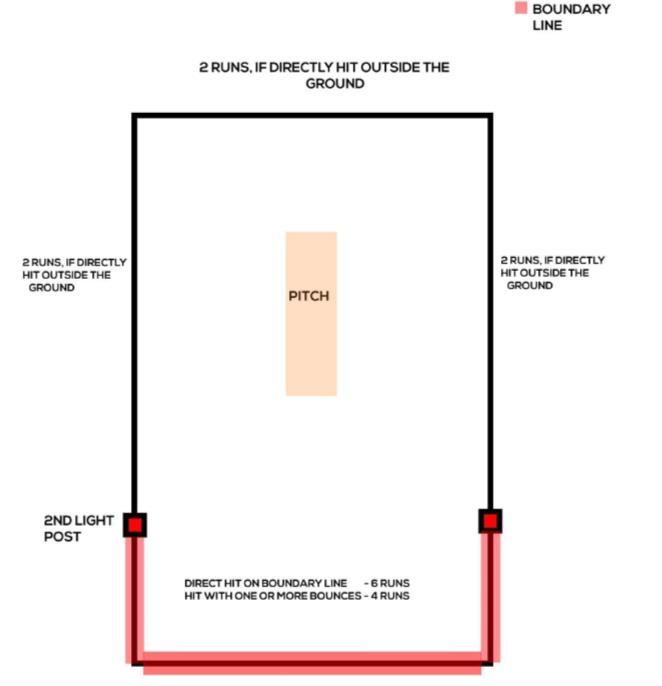
INTRODUCTION
"The
CAT Cricket League (CCL) is a high-caliber cricket tournament that promotes excellence, healthy competition, and sportsmanship by adhering to its own standards."
PURPOSE OF RULE BOOK
The rule book ensures standardization and consistency across all matches, providing clear guidelines for gameplay and conduct. It promotes fairness by establishing uniform rules that prevent any team or player from gaining an unfair advantage. The book also facilitates the resolution of disputes and appeals, maintaining order during the game. Additionally, it outlines player conduct and game management, ensuring smooth and equitable play
1. EQUIPMENT
1.1 BAT, BALL AND FIELDING EQUIPMENTS
•The CAT Cricket League (CCL) management will provide all necessary bats and balls for use during matches.
•Players are not required to bring their own bats.
•Fielding equipment, including stumps, bails, boundary markers, will be provided by the CCL management.
•All players must wear their designated team jersey during matches to maintain uniformity and team identity
•Players are required to wear dark shade blue, black or grey track pants while on the field.
•Players must wear appropriate sports shoes during the match
2. PLAYERS
2.1 NUMBER OF PLAYERS
•Only seven players from each team are permitted on the field of play at any given time during a match.
•If a team sets more than the allowed number of fielders on the field at any time, the umpire will issue a formal warning to the team.
•If the same team repeats the violation after receiving the initial warning, the team will be disqualified from the match.
•Only players who have been selected through the auction process are eligible to participate in the match
2.2 ROLE OF PLAYERS
•Each team must designate players' roles as Batsman, Bowler, or All-Rounder before the match.
•A complete list of players and their designated roles must be submitted to the Commentary Committee members prior to the start of the match
3. GAME STRUCTURE
3.1 MATCHES
•Each team will participate in a total of four regular matches during the league phase.
•Teams that qualify based on their performance in the regular matches will advance to the semifinal round.
•The team that finishes at the top of the league table at the end of the group stage will qualify directly for the final match.
•The winners of the semifinal matches will compete in the final match to determine the overall champion of the tournament.
•There will be no additional time allocated for warm-up beyond the time designated for the team toss. The total time allocated for completing a match is 30 minutes, Each innings must be completed within 15 minutes. If an innings exceeds the 15-minute limit, a penalty of 5 runs will be imposed for every additional two overs or part thereof beyond the allotted time.
•The next team scheduled to play must be present and ready in the ground while the second innings is ongoing.
•If a team arrives late and fails to be ready according to the time schedule, that team will be disqualified from the match. The opposing team will be awarded 2 points for the disqualification of the late-arriving team.
•1 minute for innings break and 1 minute for match break.
3.2 OVERS
•Each boys' team is allotted a total of 4 overs per match.
•Each girls' team is allotted a total of 4 overs per match.
3.3 WICKETS
•Once 6 wickets have fallen, the innings will be considered complete, regardless of the number of overs remaining.
3.3
SUPER OVER
•A Super Over is allocated only for the semi-finals and finals. If the Super Over ends in a tie, an additional Super Over will be provided to determine the winner.
4. GAMEPLAY
4.1
BATTING
•A new batsman must take the crease within ninety (90) seconds of the dismissal of the previous batsman.
•If the new batsman does not arrive within the stipulated time, the incoming batsman will be considered out, and the team will lose a wicket.
•If a batsman sustains an injury and is unable to continue batting, the batsman may leave the field as "retired hurt.”
➢ If a batsman has sufficient time to reach the crease but is obstructed by the bowler, the batsman shall not be considered out. The final decision regarding this situation will be made by the umpires.
4.2
BOWLING
•In a 4-over match for boys and gils, a maximum of one bowlers may each bowl 2 overs, totaling 2 overs. The remaining 2 over must be bowled by any other bowler(s)
4.2 BOWLING
•In a 4-over match for girls, a maximum of one bowler may bowl 2 overs. The remaining 2 overs must be bowled by other bowlers.
•If a bowler sustains an injury while bowling an over, the team captain must inform the umpire immediately about the injury.
•Upon notifying the umpire, the remaining deliveries of the injured bowler’s over may be bowled by another bowler from the team, subject to the umpire’s approval.
•A bowler is allowed to bowl only one (1) bouncer per over. Any bouncer delivered after the first one in the same over will be considered a No ball+Freehit
➢ The bowler is strictly prohibited from delivering the ball underarm. If a bowler delivers the ball underarm, the umpire will call it a re-delivery. If the bowler delivers the ball underarm again, the umpire will call it a No ball+Freehit.
•For each no ball called by the umpire, the batting side will be awarded 1 run as a penalty.
•A delivery that is above waist height of the batsman when in their normal stance is considered a no ball. The delivery following a waist-high no ball will be designated as a "free hit.“
•During the free hit delivery, the batsman cannot be dismissed by traditional means (e.g., bowled, caught, leg before wicket), except for being run out.
•If the bowler’s back foot does not land within and does touch the return crease, the delivery is also ruled a no ball. The delivery following a no ball will be designated as a “free hit”.
➢ If a batsman obstructs the fielder, bowler, or wicketkeeper in a run-out situation, the batsman shall be considered out. The decision will be made by the umpires based on the obstruction.
5. WAYS OF GETTING OUT
5.1 BOWLED
•A batsman can be dismissed by being bowled if and only if the delivery is not ruled a no ball.
5.2 LBW
•The LBW (Leg Before Wicket) rule will not be applied in this league
5.3 CAUGHT
•A batsman is only considered out if the ball is caught directly by a fielder without touching the nets or the ground.
5.4 RUNOUT
•A batsman is considered run out if, while attempting a run, the stumps are put down by the opposing team before the batsman has grounded any part of their body or bat behind the popping crease.
➢ If both batsmen arrive at the same end of the crease and the wicket is put down by the opposing team, the batsman who is nearer to the crease will be declared out.
➢ If both batsmen run to the same end of the crease and one batsman reaches the crease while the other does not, the batsman who has not reached the crease will be out only if the fielding side successfully throws the ball to the other end and puts down the stumps at that end.
➢ For a run out attempt after the ball hits the nets, the ball must be properly relayed to the bowler, another fielder, or the wicketkeeper before the run out attempt can be made.
5.5 STUMPED
•A batsman is out stumped if, while out of their crease and attempting a shot or moving towards the bowler, the wicketkeeper puts down the stumps with the ball before the batsman returns to the crease.
5.6
HIT WICKET
•A batsman is considered out hit wicket if, while the ball is in play, they accidentally break their own stumps with their body, bat, or equipment
5.6 MANKADING WICKET
•A mankading wicket is awarded when the non-striker leaves the crease before the bowler has delivered the ball, and the bowler successfully removes the bails at the non-striker's end.
6. SCORING
6.1 BOUNDARIES
•Runs can be scored by hitting the ball to the boundary as follows : Four runs and Six runs.
6.2 EXTRAS
•Runs can be scored through various types of extras, which include wides, no balls, byes and leg byes
•If the ball is pitched outside the pitch , the umpire will call and signal a no ball + freehit.
6.3
OVERTHROW
If the ball is thrown by a fielder and reaches or crosses the boundary, either directly or after deflection, the batting side is awarded the runs completed by the batsmen plus an additional boundary score. The umpire will determine the number of runs based on whether the ball crossed the boundary line or touched it.
7. FIELD SETTING
7.1 FIELDING
•Only seven players from each team are allowed to be on the field of play at any given time during a match.
•A maximum of three players from the fielding side are allowed to be positioned on the boundary line at any given time during the match.
8. PITCH LENGHT
•BOYS: The length of the pitch shall be 64 ft yards (19.2 meters) from one set of stumps to the other.
•GIRLS: The length of the pitch shall be 60ft (18 meters) from one set of stumps to the other.
•The pitch length is measured from the middle of the stumps at one end to the middle of the stumps at the opposite end.
9. BOUNDARY LINE
9.1 BOUNDARY LINE (4’s & 6’s) AND 2 RUNS SCORE
9. 2 RUNS SCORE GIRLS TEAM
• If the ball hits the second horizontal post (the top of the stumps) or any part above it, other than crossing the boundary, the batting side will be awarded two runs. This ruling applies specifically to women's cricket.




